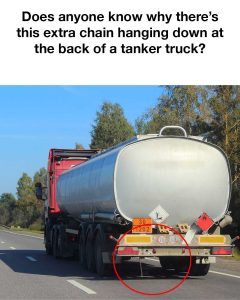Tanker trucks are specialized vehicles designed to transport liquid or gaseous products, such as fuel, water, chemicals, and food-grade liquids. These trucks are equipped with a cylindrical tank mounted on a chassis, which is engineered to safely contain and transport these substances. The design and components of tanker trucks are crucial for ensuring the safe and efficient delivery of their cargo. Among the various components, one might notice an extra chain hanging down at the back of the truck. This seemingly simple feature plays a significant role in the overall safety and functionality of the vehicle.

The Purpose of the Extra Chain on Tanker Trucks
The extra chain hanging from the back of a tanker truck serves as a grounding device. Its primary purpose is to dissipate static electricity that can build up during the transportation of flammable liquids. As the truck moves, friction between the liquid and the tank, as well as the movement of the truck itself, can generate static electricity. If not properly managed, this static charge can lead to sparks, which pose a significant risk of igniting the flammable cargo. The chain drags along the ground, providing a path for the static electricity to safely discharge into the earth, thereby reducing the risk of fire or explosion.
Historical Context: How the Extra Chain Became Standard
The use of grounding chains on tanker trucks became standard practice as the dangers of static electricity in fuel transportation were better understood. In the early days of fuel transport, accidents caused by static discharge were more common, leading to devastating fires and explosions. As a result, safety regulations evolved to include measures for static dissipation. The grounding chain emerged as a simple yet effective solution and became a standard feature on tanker trucks worldwide. Over time, this practice has been reinforced by industry standards and regulations, ensuring that all tanker trucks are equipped with this crucial safety feature.
Safety Considerations and Regulations
Safety is a paramount concern in the transportation of hazardous materials, and regulations governing tanker trucks are stringent. Various international and national bodies, such as the Department of Transportation (DOT) in the United States, have established guidelines to ensure the safe operation of these vehicles. These regulations cover aspects such as tank construction, pressure limits, and static electricity management. The grounding chain is a mandated safety feature, and its presence and functionality are often checked during routine inspections. Compliance with these regulations is essential to prevent accidents and ensure the safety of both the transport personnel and the public.
The Science Behind Static Electricity and Fuel Transport
Static electricity is a common phenomenon that occurs when two surfaces come into contact and then separate, causing an imbalance of electric charges. In the context of fuel transport, the movement of liquid within the tanker can generate static electricity due to friction. This is particularly concerning with flammable liquids, as a static discharge can ignite vapors and lead to explosions. The grounding chain provides a conductive path for the static charge to dissipate safely into the ground, preventing the buildup of potentially dangerous electrical energy. Understanding the science behind static electricity is crucial for developing effective safety measures in fuel transport.
Alternative Methods for Grounding Tanker Trucks
While grounding chains are a traditional method for dissipating static electricity, there are alternative technologies and methods used in modern tanker trucks. Some trucks are equipped with static grounding reels, which are retractable cables that can be attached to a grounding point during loading and unloading. Additionally, anti-static additives can be mixed with the fuel to reduce static buildup. Advanced materials and coatings are also being developed to minimize friction and static generation. These alternatives provide additional layers of safety and are often used in conjunction with grounding chains to enhance the overall safety of fuel transport operations.
Common Misconceptions About the Extra Chain
One common misconception about the extra chain on tanker trucks is that it is merely a leftover piece of equipment or serves no real purpose. In reality, the chain is a critical safety feature designed to prevent static discharge. Another misconception is that the chain is used to stabilize the truck or assist with braking, which is not the case. Some people may also believe that the chain is outdated and unnecessary with modern technology, but it remains a vital component due to its simplicity and effectiveness in grounding static electricity.
The Role of the Extra Chain in Preventing Accidents
The grounding chain plays a crucial role in preventing accidents associated with static electricity in fuel transport. By providing a continuous path to the ground, the chain ensures that any static charge generated during transport is safely dissipated. This reduces the risk of sparks that could ignite flammable vapors, thereby preventing fires and explosions. The presence of the chain is a simple yet effective measure that significantly enhances the safety of tanker truck operations, protecting both the transport personnel and the surrounding environment.
Maintenance and Inspection of the Extra Chain
Regular maintenance and inspection of the grounding chain are essential to ensure its effectiveness. Over time, the chain can become worn, corroded, or damaged, which can compromise its ability to dissipate static electricity. During routine inspections, the chain should be checked for signs of wear and tear, and any damaged sections should be replaced promptly. Ensuring that the chain maintains good contact with the ground is also important for its proper functioning. Adhering to maintenance schedules and inspection protocols is crucial for maintaining the safety and reliability of the grounding system.
Conclusion: The Importance of the Extra Chain in Fuel Transport Safety
In conclusion, the extra chain hanging from the back of a tanker truck is a vital safety feature that plays a key role in preventing static-related accidents. Its ability to safely dissipate static electricity into the ground helps mitigate the risk of fires and explosions during the transport of flammable liquids. Despite its simplicity, the grounding chain is an essential component of tanker truck safety, supported by regulations and industry standards. Understanding its purpose and maintaining its functionality are crucial for ensuring the safe and efficient transport of hazardous materials.




